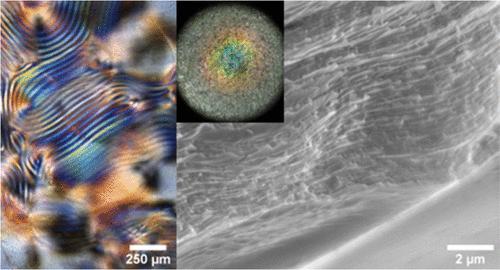黄原胶溶致液晶液制备固体膜的结构着色研究
IF 16
1区 材料科学
Q1 CHEMISTRY, MULTIDISCIPLINARY
引用次数: 0
摘要
受自然界手性分子螺旋自组装的启发,通过干燥胆甾纳米颗粒悬浮液或聚合物溶液,可以制备出有前途的光子材料彩虹膜。迄今为止,生物基纤维素纳米晶体悬浮液是制备此类薄膜的主要来源,这涉及到原料的水解,大量消耗浓硫酸,并严格控制干燥过程。为了提高可持续性,我们在这里证明,通过干燥超声波处理的黄原胶水溶液,无需额外的化学处理,并在温和的蒸发控制下,可以产生结构上着色的、不脆的薄膜。通过调节超声作用时间,可以调节黄原胶的链长,使其胆甾液晶行为发生明显变化。令人惊讶的是,沥青从胆甾液晶到干燥薄膜的演变并不遵循与纤维素纳米晶体悬悬液相同的机制,而是表现出更明显的收缩。我们运用各种理论模型分析了这种行为,并讨论了链柔韧性的影响和胶凝点。本文章由计算机程序翻译,如有差异,请以英文原文为准。

Structural Coloration of Solid Films Prepared from Xanthan Lyotropic Liquid Crystal Solutions
Inspired by the helical self-assembly of chiral molecules in nature, iridescent films as promising photonic materials have been yielded by drying cholesteric nanoparticle suspensions or polymer solutions. To date, biobased cellulose nanocrystal suspensions are the main source for fabricating such films, which involve the hydrolysis of raw materials with a huge consumption of concentrated sulfuric acid and rigorous control of the drying process. To enhance sustainability, we here demonstrate that structurally colored, nonbrittle films can be produced via drying ultrasonically treated xanthan water solutions without additional chemical treatment and under mild evaporation control. By adjustment of the duration of ultrasonication, the chain length of xanthan gum can be tuned, leading to a distinct change of its cholesteric liquid crystal behavior. Surprisingly, the evolution of the pitch from the cholesteric liquid crystal to the dried film does not follow the same mechanism as that known from cellulose nanocrystal suspensions but exhibits a much more pronounced shrinkage. We analyze this behavior by applying various theoretical models and discuss the impact of chain flexibility and the point of gelation.
求助全文
通过发布文献求助,成功后即可免费获取论文全文。
去求助
来源期刊

ACS Nano
工程技术-材料科学:综合
CiteScore
26.00
自引率
4.10%
发文量
1627
审稿时长
1.7 months
期刊介绍:
ACS Nano, published monthly, serves as an international forum for comprehensive articles on nanoscience and nanotechnology research at the intersections of chemistry, biology, materials science, physics, and engineering. The journal fosters communication among scientists in these communities, facilitating collaboration, new research opportunities, and advancements through discoveries. ACS Nano covers synthesis, assembly, characterization, theory, and simulation of nanostructures, nanobiotechnology, nanofabrication, methods and tools for nanoscience and nanotechnology, and self- and directed-assembly. Alongside original research articles, it offers thorough reviews, perspectives on cutting-edge research, and discussions envisioning the future of nanoscience and nanotechnology.
 求助内容:
求助内容: 应助结果提醒方式:
应助结果提醒方式:


